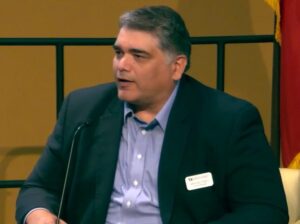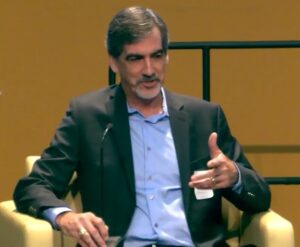
This is the second in a three-part series to summarize takeaways from the West Houston Association’s Quality Planned Development symposium entitled “Building Tomorrow Together” that took place on June 21, 2024.
In the Clear Solutions panel, Lauren Morales, a financial advisor with Rathmann and Associates, led an engaging session with Taylor Reed, a partner and project manager from Vogler and Spencer Engineering; Mike Thornhill, Vice President of Compliance at Si Environmental and a board member at West Harris County Regional Water Authority; and Mike Turco, the General Manager of both Harris-Galveston and Fort Bend Subsidence Districts. Each expert shared valuable insights into managing groundwater and water resources when experiencing new development and population growth. They talked about building upon existing well water systems to facilitating surface water conversion and explored strategies for thoughtful long-range regional planning for resiliency.

Mike Turco, HGSD
Mike Turco started the discussion by explaining subsidence and its impact on groundwater pumping. He emphasized that subsidence, a gradual lowering of land surface due to groundwater extraction, has been a longstanding issue in the Texas Gulf Coast, notably around Houston since the early 1900s. He highlighted that groundwater withdrawal reduces aquifer pressure, causing the compaction of clay layers and visible subsidence on the surface. Over decades, areas like the Ship Channel have experienced significant subsidence, up to 10 feet, while northwest Harris County has seen 7-8 feet of subsidence.
To address this issue, Harris-Galveston Subsidence District (established in 1975) and Fort Bend Subsidence District (1989) have focused on reducing groundwater dependency. They’ve promoted surface water projects as alternatives to groundwater, which include some of the largest projects in the country. These efforts have successfully curbed subsidence rates in parts of eastern and central Harris County. However, northern and western Harris County and Fort Bend County still experience subsidence rates of 0.5 to 1 foot per decade due to continued groundwater usage, posing challenges for development and infrastructure stability.
The discussion shifted towards strategies for managing groundwater and water resources in growing cities. Taylor Reed advocated for leveraging new technologies and emphasizing water conservation. He noted that older cities often suffer significant groundwater losses due to outdated infrastructure. By upgrading water lines and adopting alternative sources like non-potable water systems and wastewater reuse for irrigation, cities can reduce reliance on groundwater and prepare for future surface water integration.

Mike Thornhill, SiEnvironmental
Mike Thornhill elaborated on ongoing projects aimed at transitioning from groundwater to surface water. He discussed the West Harris County Regional Water Authority‘s efforts, which involve over 120 Municipal Utility Districts (MUDs) collaborating to secure alternative water sources. The Authority has expanded the Northeast plant’s capacity to accommodate increasing water demands and is constructing a 55-mile pipeline from Lake Houston to West Houston. This pipeline, scheduled for completion within the next 18 months, aims to reduce groundwater usage and enhance water distribution efficiency across the region.
Thornhill and Turco highlighted the phased approach to achieving water conversion targets, with an interim goal of 60% by next year and even more complete conversion of 80+% by 2035. The panelists all emphasized the importance of maintaining groundwater wells as a backup during emergencies and ensuring resilience in water supply infrastructure.
The panel also addressed strategies for cities without access to surface water. Reed underscored the importance of maximizing groundwater efficiency through stormwater capture, wastewater reuse, and smart metering to detect leaks and reduce consumption. Thornhill added that the West Harris County Regional Water Authority incentivizes water conservation through rebate programs for infrastructure upgrades that enhance water efficiency. They also stressed the need for comprehensive city planning that includes underground infrastructure, especially water and wastewater systems. Reed highlighted that while roadways and bridges often dominate city improvement plans because they can be seen, investing in underground and less attractive infrastructure is crucial for preventing water shortages and infrastructure failures.
The need for education of both the public and public officials was heard throughout the panel. Mike Turco noted, “As an industry, we need to do a better job of educating decision-makers and the public about the complexities of water infrastructure. As a groundwater hydrologist, I’ve dealt with underground systems my entire career. Unfortunately, this work isn’t very visible or glamorous, and people often don’t appreciate what goes into ensuring water comes out of the tap and safely goes down the drain.”

Taylor Reed, Vogler & Spencer
 It was discussed that many people outside the water industry have little appreciation for this work. “Everyone wants to be known for building new subdivisions, like Bridgeland or Town Lake. My claim to fame might be replacing 100,000 linear feet of water line, which few people notice or care about,” said Taylor Reed.
It was discussed that many people outside the water industry have little appreciation for this work. “Everyone wants to be known for building new subdivisions, like Bridgeland or Town Lake. My claim to fame might be replacing 100,000 linear feet of water line, which few people notice or care about,” said Taylor Reed.
The panel noted that many issues of water infrastructure take time to solve, but they need to be taken seriously and be on the minds of city engineers and planners today, or they will only get worse in the future. Moreover, as development continues to expand away from the City of Houston, an eye must be kept on the older infrastructure that everyone in the region relies on. Precinct 4 has done an excellent job reaching out to older facilities, asking how they can help improve infrastructure and connectivity. This approach ensures that people continue to live in and maintain these areas rather than moving to new developments, leaving older neighborhoods to decay.
The panel concluded with insights into future water management strategies, including the development of Allen Creek Reservoir. Mike Turco shared that the reservoir is intended to provide water to the western side of the area, particularly Fort Bend County. However, it is still a long way from completion and is unlikely to be available before the development and water needs in Western Fort Bend County become an issue.
An audience member asked about Magnolia’s water needs which highlighted how Magnolia serves as a prominent example of what happens when water resources are not adequately planned for. The situation foreshadows the potential expansion in Brookshire, Waller, Sealy, and other smaller cities. Although the City of Magnolia itself may not have expanded its footprint, the number of people it serves has grown significantly due to nearby development. More people are using local resources, shopping at stores, and eating at restaurants, thereby increasing the demand on the water infrastructure.
 On behalf of Mike Turco: The “Water My Yard” program by Texas A&M AgriLife Extension in partnership with the subsidence districts uses local weather data to optimize irrigation schedules, promoting efficient water use for homes, businesses, and municipalities. Visit WaterMyYard.org to learn more.
On behalf of Mike Turco: The “Water My Yard” program by Texas A&M AgriLife Extension in partnership with the subsidence districts uses local weather data to optimize irrigation schedules, promoting efficient water use for homes, businesses, and municipalities. Visit WaterMyYard.org to learn more.
